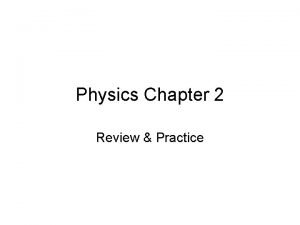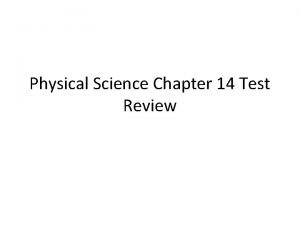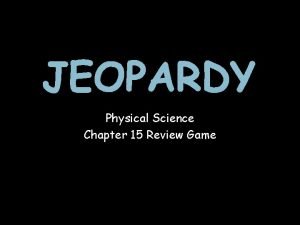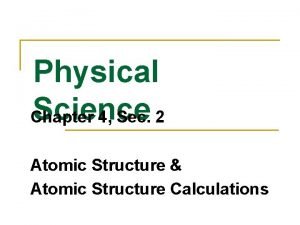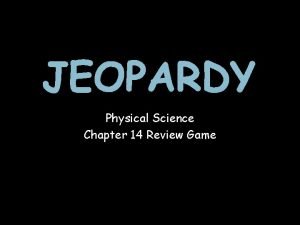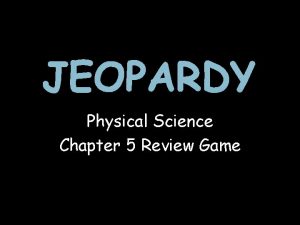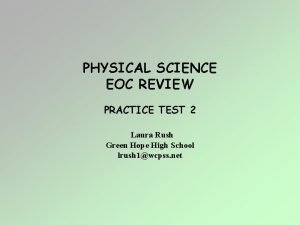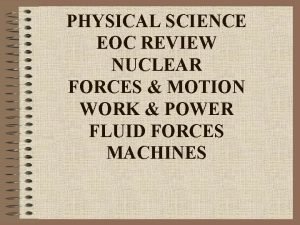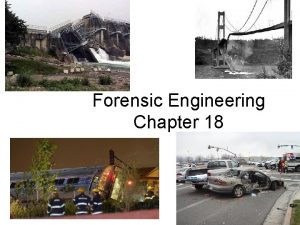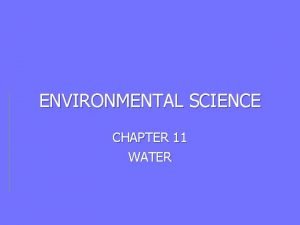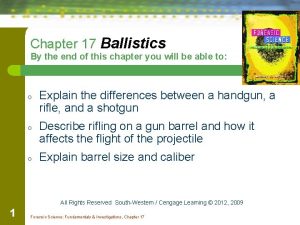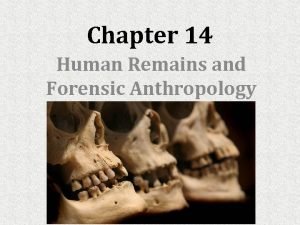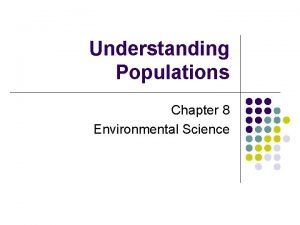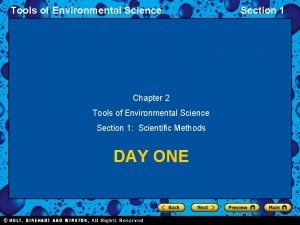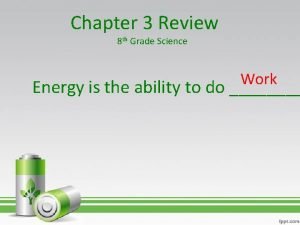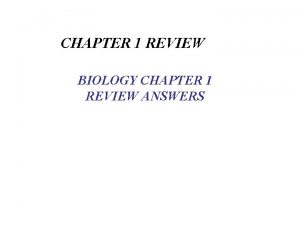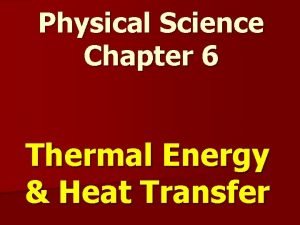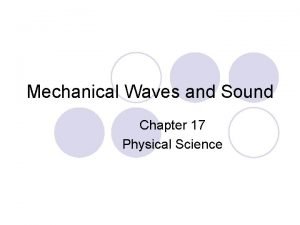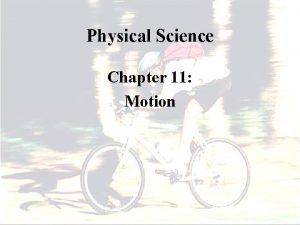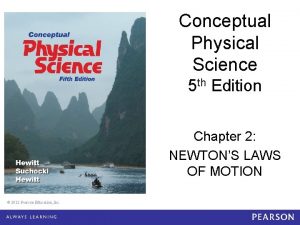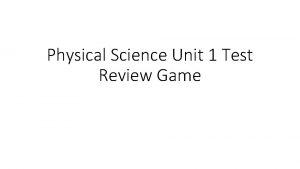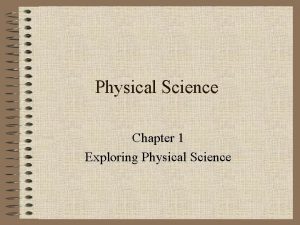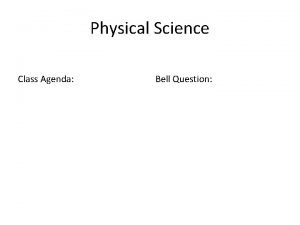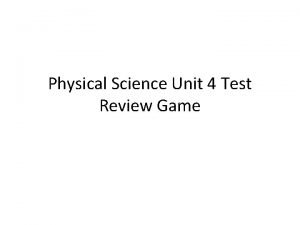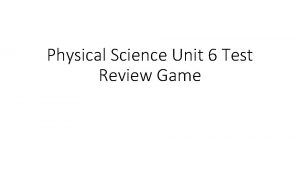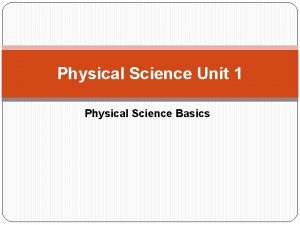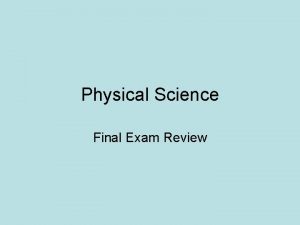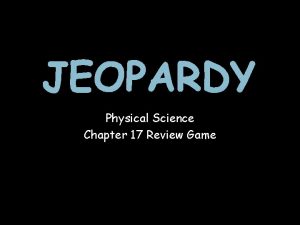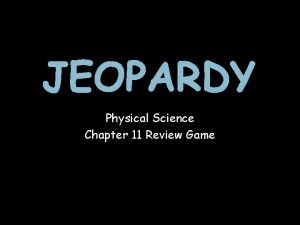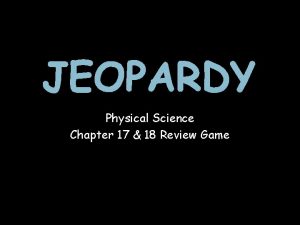Physical Science Chapter 6 Test Review Game Question































- Slides: 31

Physical Science Chapter 6 Test Review Game

Question 1 • Fluorine forms a binary compound with lithium. What is the name of this compound? • • A. lithium fluorine B. lithium fluoride C. fluorine lithium D. fluorine lithide B

Question 2 • Which of the following elements is a noble gas? • • A. Ne B. F C. C D. Li A

Question 3 • Typically, atoms gain or lose electrons to achieve • • A. ionization B. vaporization C. a stable electron configuration D. an exchange of energy C

Question 4 • Covalent bonds are made of which of the following? • • A. only metals B. only nonmetals C. both metals and nonmetals D. all of the above B

Question 5 • In the name carbon dioxide, the prefix of the second word indicates that a molecule of carbon dioxide contains • • A. a polyatomic ion B. two oxygen atoms C. two carbon atoms D. an ionic bond B

Question 6 • In an electron dot diagram, each dot represents a(an) _____. • • A. neutron B. oxidation number C. proton D. valence electron D

Question 7 • Which of the following groups contain three elements with stable electron configurations? • • A. argon, neon, barium B. xenon, neon, boron C. lithium, krypton, argon D. helium, xenon, neon D

Question 8 • The formation of an ionic bond involves the • • A. transfer of neutrons B. transfer of protons C. transfer of electrons D. sharing of electrons C

Question 9 • The compound whose formula is SO 3 is called • • A. sulfur trioxide B. sulfur oxygen C. monosulfur trioxide D. sulfur oxide A

Question 10 • In an ionic compound, the attractions between cations and _______ hold the compound together. • • A. anions B. transition elements C. noble gases D. metals A

Question 11 • Beryllium and chlorine form a binary ionic compound with a one-totwo ratio of beryllium ions to chloride ions. The formula for the compound is • • A. Be. Cl 2 B. 2 Be. Cl C. Be 2 Cl 2 D. Be 2 Cl A

Question 12 • The elements that make up a compound and the exact number of atoms of each element in a unit of the compound can be shown in a _____. • • A. chemical symbol B. subscript C. superscript D. chemical formula D

Question 13 • What is the total number of atoms in the compound Ca. Cl. O 3? • • A. 2 B. 3 C. 4 D. 5 D

Question 14 • What is the name of the compound with the formula Na. Cl? • • A. chlorine sodium B. sodium chlorate C. sodium chloride D. sodium dichloride C

Question 15 • What is the correct formula for magnesium oxide? • • A. Mg. O B. Mg. O 2 C. Mg 2 O 2 D. Mg 2 O A

Question 16 • Each molecule of table sugar, C 12 H 22 O 11, contains • • A. 0 carbon atoms B. 1 atom of carbon C. 6 atoms of carbon D. 12 atoms of carbon D

Question 17 • An anion has a ______ charge. • • A. positive B. negative C. neutral D. both positive and negative B

Question 18 • The name dinitrogen tetroxide tells you that this compound contains • • A. two nitrogen atoms and two oxygen atoms B. four nitrogen atoms and two oxygen atoms C. two nitrogen atoms and four oxygen atoms D. four nitrogen atoms and four oxygen atoms C

Question 19 • In the binary ionic compound potassium bromide, KBr, the element that forms cations is • • A. bromine B. potassium C. potassium bromide D. there is no cation B

Question 20 • True or False • Particles formed from the covalent bonding of atoms are called ions. False

Question 21 • True or False • When an atom gains or loses electrons, the charged particle that results is called a molecule. False

Question 22 • True or False • The formula SO 4 -2 stands for sulfur oxide. False

Question 23 • True or False • An atoms is chemically unstable when its outer energy level contains all the electrons it can hold. False

Question 24 • True or False • An element’s oxidation number indicates how many electrons the element must gain, lose, or share to become stable. True

Question 25 • True or False • In the binary ionic compound lithium iodide, Li. I, iodine would form the anions. True

Question 26 • True or False • The chemical formula for calcium chloride, Ca. Cl 2, shows that the compound contains two calcium ions for every chloride ion. False

Question 27 • True or False • KBr is the formula for an ionic compound. The fact that neither symbol is followed by a subscript means that there is a one-to-one ratio of ions in the compound. True

Question 28 • True or False • In sodium chloride, Na. Cl, the sodium ions are the cations. True

Question 29 • True or False • In the binary ionic compound potassium bromide, KBr, the element that forms cations is bromine. False

Question 30 (BONUS) • Match the following. You must get ALL of them right to get the points. • 1. have a charge of -1 • 2. do not react • 3. have 6 valence electrons • 4. have 2 valence electrons • 5. have a charge of +1 a. alkali metals b. alkaline earth metals c. group 16 1. d d. halogens 2. e e. noble gases 3. c 4. b 5. a
 Physics chapter 2 review
Physics chapter 2 review If you perform 40 joules of work
If you perform 40 joules of work Chapter 15 review physical science
Chapter 15 review physical science Physical science chapter 4 review
Physical science chapter 4 review Chapter 14 review physical science
Chapter 14 review physical science Chapter 5 review physical science
Chapter 5 review physical science As your room gets messier day by day, entropy is
As your room gets messier day by day, entropy is Chapter 16 review physical science
Chapter 16 review physical science Costa level of questions
Costa level of questions Physical science eoc review
Physical science eoc review Physical science eoc review
Physical science eoc review Chapter 4 work and energy section 1 work and machines
Chapter 4 work and energy section 1 work and machines Noah carried a skateboard
Noah carried a skateboard Brances of science
Brances of science Natural and physical science
Natural and physical science My favourite subject is c
My favourite subject is c Chapter review motion part a vocabulary review answer key
Chapter review motion part a vocabulary review answer key The golden book of camping
The golden book of camping Chapter 11 water environmental science
Chapter 11 water environmental science Nibis definition forensics
Nibis definition forensics Forensic anthropology unit
Forensic anthropology unit Environmental science chapter 13
Environmental science chapter 13 Chapter 8 environmental science
Chapter 8 environmental science Tools of environmental science
Tools of environmental science Chapter 3 review 8th grade science
Chapter 3 review 8th grade science Chapter 1 review answers
Chapter 1 review answers Three levels of biodiversity
Three levels of biodiversity Unit test unit test review algebra 2
Unit test unit test review algebra 2 Chapter 6 physical science
Chapter 6 physical science Which travels along a surface separating two media
Which travels along a surface separating two media Chapter 11 physical science
Chapter 11 physical science Conceptual physical science practice sheet chapter 2
Conceptual physical science practice sheet chapter 2
